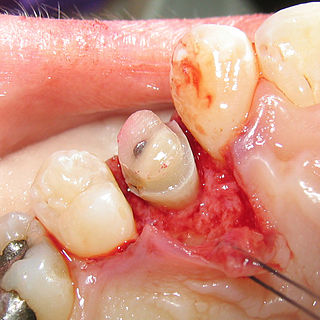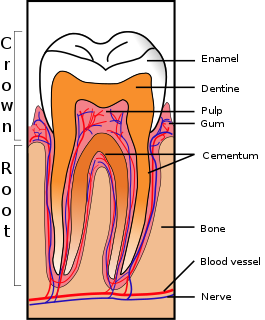In medicine, a subluxation is an incomplete or partial dislocation of a joint or organ. According to the WHO, it is a "significant structural displacement", and therefore, unlike the chiropractic belief of "vertebral subluxation", is always visible on static imaging studies, such as X-rays. The exact definition depends on the anatomical part being involved.

The human teeth function to mechanically break down items of food by cutting and crushing them in preparation for swallowing and digesting. Humans have four types of teeth: incisors, canines, premolars, and molars, which each have a specific function. The incisors cut the food, the canines tear the food and the molars and premolars crush the food. The roots of teeth are embedded in the maxilla or the mandible and are covered by gums. Teeth are made of multiple tissues of varying density and hardness.

Dental surgery is any of a number of medical procedures that involve artificially modifying dentition; in other words, surgery of the teeth, gums and jaw bones.

Endodontics is the dental specialty concerned with the study and treatment of the dental pulp.

Toothache, also known as dental pain, is pain in the teeth or their supporting structures, caused by dental diseases or pain referred to the teeth by non-dental diseases. When severe it may impact sleep, eating, and other daily activities.

The periodontal ligament, commonly abbreviated as the PDL, is a group of specialized connective tissue fibers that essentially attach a tooth to the alveolar bone within which it sits. It inserts into root cementum one side and onto alveolar bone on the other.

Tooth development or odontogenesis is the complex process by which teeth form from embryonic cells, grow, and erupt into the mouth. For human teeth to have a healthy oral environment, all parts of the tooth must develop during appropriate stages of fetal development. Primary (baby) teeth start to form between the sixth and eighth week of prenatal development, and permanent teeth begin to form in the twentieth week. If teeth do not start to develop at or near these times, they will not develop at all, resulting in hypodontia or anodontia.
A dental emergency is an issue involving the teeth and supporting tissues that is of high importance to be treated by the relevant professional. Dental emergencies do not always involve pain, although this is a common signal that something needs to be looked at. Pain can originate from the tooth, surrounding tissues or can have the sensation of originating in the teeth but be caused by an independent source. Depending on the type of pain experienced an experienced clinician can determine the likely cause and can treat the issue as each tissue type gives different messages in a dental emergency.

Crown lengthening is a surgical procedure performed by a dentist, or more frequently a specialist periodontist. There are a number of reasons for considering crown lengthening in a treatment plan. Commonly, the procedure is used to expose a greater amount of tooth structure for the purpose of subsequently restoring the tooth prosthetically. However, other indications include accessing subgingival caries, accessing perforations and to treat aesthetic disproportions such as a gummy smile. There are a number of procedures used to achieve an increase in crown length.

Occlusal trauma is the damage to teeth when they are not properly aligned when the jaw is closed.
Root resorption is the progressive loss of dentine and cementum by the action of osteoclasts. This is a physiological process in the exfoliation of the primary dentition, caused by osteoclast differentiation due to pressure exerted by the erupting permanent tooth. However, in the secondary dentition the process is pathological.

Cracked tooth syndrome (CTS) is where a tooth has incompletely cracked but no part of the tooth has yet broken off. Sometimes it is described as a greenstick fracture. The symptoms are very variable, making it a notoriously difficult condition to diagnose.
Pulp necrosis is a clinical diagnostic category indicating the death of cells and tissues in the pulp chamber of a tooth with or without bacterial invasion. It is often the end result of many cases of dental trauma, caries and irreversible pulpitis.

Dental trauma refers to trauma (injury) to the teeth and/or periodontium, and nearby soft tissues such as the lips, tongue, etc. The study of dental trauma is called dental traumatology.
Dental subluxation is a traumatic injury to the periodontal tissue in which the tooth has increased mobility but has not been displaced from its tooth socket.

Dental avulsion is the complete displacement of a tooth from its socket in alveolar bone owing to trauma.

Tooth mobility is the medical term for loose tooth.
Tooth ankylosis is the pathological fusing of cementum or dentine of a tooth root to the alveolar bone. Ankylosis of teeth is uncommon, it more often occurs in deciduous teeth than permanent teeth.
Pulp canal obliteration is a condition which can occur in teeth where hard tissue is deposited along the internal walls of the root canal and fills most of the pulp system leaving it narrowed and restricted.











